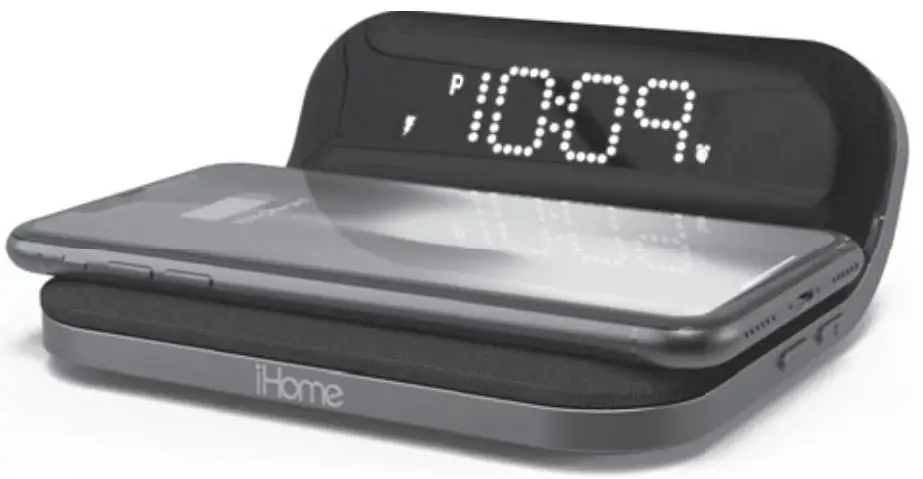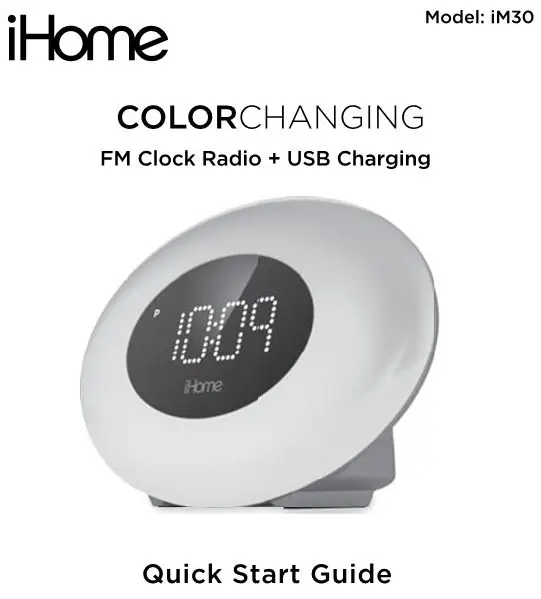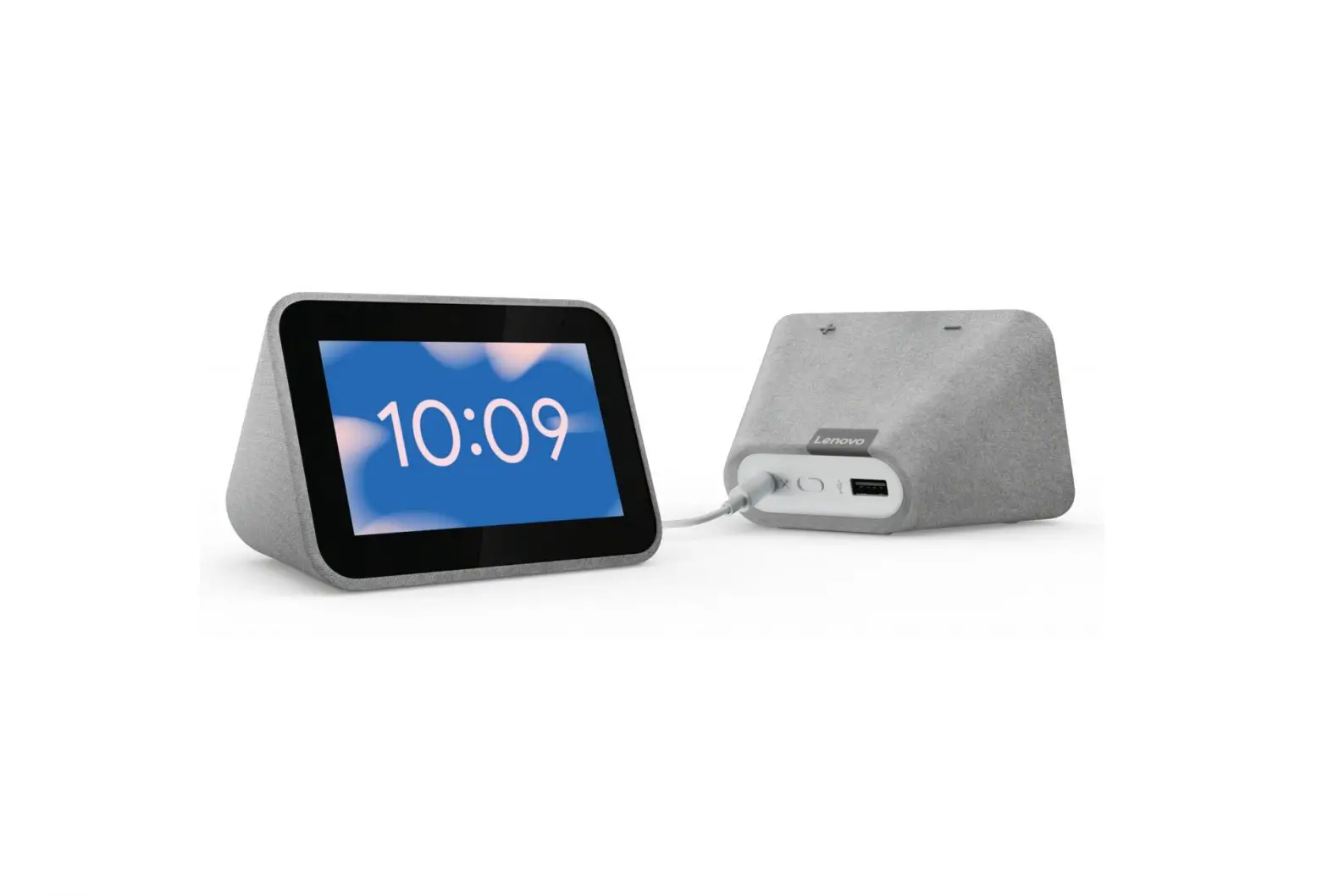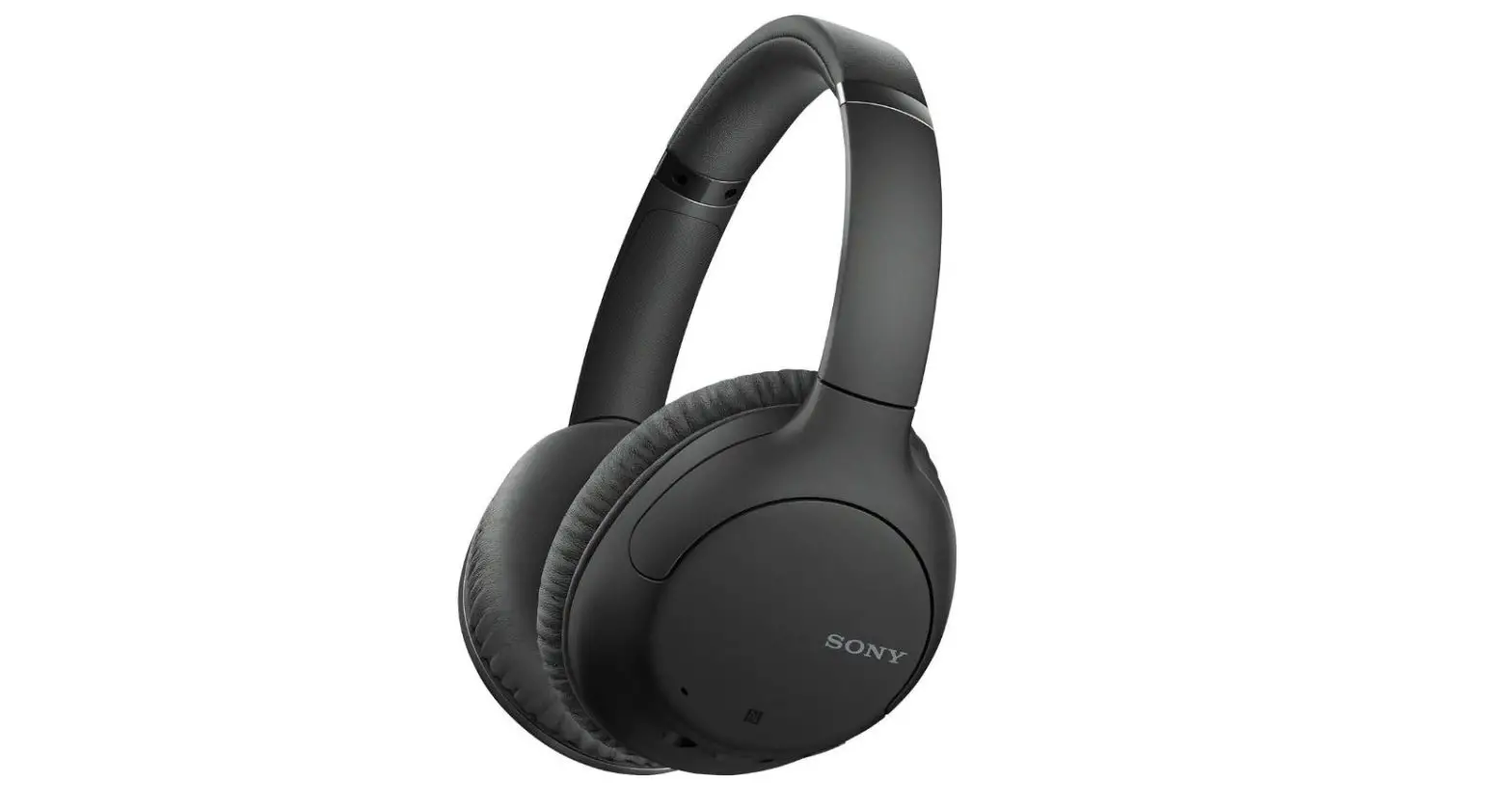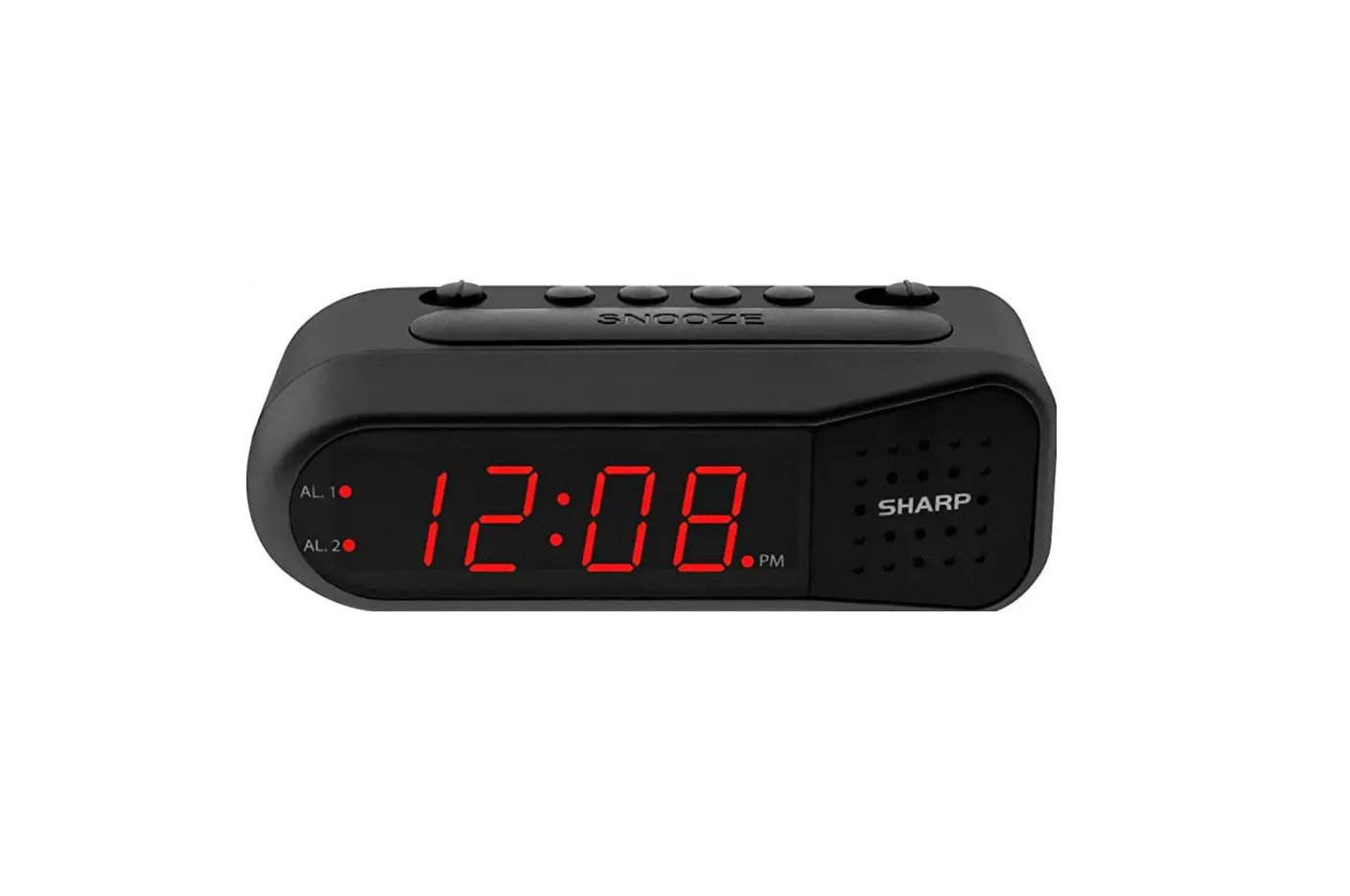User Manual


iHome iW18 Bedside/Office Clock with Dual Charging
FEATURES & FUNCTIONS



GETTING STARTED
Step 1: Connecting the Unit
Before use, remove the battery pull tab from the bottom of the unit. Connect the included AC adapter to the DC jack located on the back of the unit and connect the other end to a working wall outlet.

Step 2: Setting Your Clock

- Press and hold the Time Set Button until the display flashes.
- Press the – or + Buttons to adjust selections and press Time Set to confirm.
- Do this for time, year, month and date.
- All done!
Daylight Savings Time (DST) Switch:
By default, the DST Switch is set to Auto and will automatically adjust the time each March and November.
DISPLAY ICONS
![]()
To adjust the brightness of the display, press the Time Set Button repeatedly to cycle through brightness settings, including OFF.
SETTING THE ALARM
Note: Each step must be completed while display is flashing or setting will time-out with any changes saved.
- Press and hold the Alarm Button for 2 seconds until the alarm time display and alarm icon flash.
- Press the – or + Buttons to adjust the alarm time to the desired time (hold for rapid setting). Make sure you set the correct AM/PM alarm time. The PM indicator appears to the left of the display.
- Press the Alarm Button to confirm the alarm time setting. The alarm schedule will flash: 7 (every day), 5 (weekdays) or 2 (weekend only). Press the – or + Buttons to select the desired alarm schedule.
- Press the Alarm Button to confirm the alarm schedule. 2 beeps will confirm alarm setting is complete. The alarm icon will remain on the display, indicating the alarm is armed.
- To turn off a sounding alarm and reset it to come on the next day at the same time, press the Alarm Button to reset alarm.
PREVIEWING THE ALARM
Press and release the desired Alarm Button as needed to preview the alarm and to toggle the alarm ON (indicated by the alarm icon) or OFF (no alarm icon).
PROGRAMMABLE SNOOZE
- To program Snooze, press down on the front of the unit for 2 seconds during normal operation (when no alarm is sounding).
- Press the – or + Buttons to select a snooze time (between 01 and 29 minutes).
- Press down and release the front of the unit to confirm setting. While the alarm is sounding, press down on the front of the unit to temporarily silence the alarm (9 minutes is the default). Snooze can be used several times during the one hour alarm cycle.
WIRELESS CHARGING
Supports:
- Qi compatible phones (also works with plastic cases up to 3mm thick)
- AirPods with wireless charging case
Place Qi compatible device face up on the charging rest as pictured below:

Note: The lightning icon may continue to blink slowly when iOS devices are fully charged.
CAUTION:
Remove metal protective or magnetic case from phone before charging. When charging phone, do not place magnetic-striped or other metal objects on the charger. Doing so could damage the object or this unit. Qi compatible phones with metallic looking finishes will charge normally.
USB CHARGING
Connect the standard size end of a USB cable (not included) to the USB port on the back of the unit and connect the other end to the charging port on your device.
(Make sure the unit is plugged into a working outlet in order to charge devices.)

BATTERY BACK-UP
The unit comes with a CR-2450 back-up battery installed to provide continuous alarm operation and clock settings in the event of a temporary power failure. Remove the battery pull tab before use. When the battery icon on the clock display is flashing, it is time to replace the back-up battery. The battery compartment is located on the bottom of the unit.
- Make sure the AC adapter is connected, or you will lose your time and alarm settings during battery replacement.
- Use a Phillips screwdriver to open the battery compartment door.
- Remove the exhausted battery from the compartment and insert 1 CR-2450 battery, checking that the + side is facing you. Replace the compartment door. Do not overtighten.

WARNING: Lithium batteries can explode or cause burns if disassembled, shorted, recharged, exposed to water, fire, or high temperatures. Do not place loose batteries in a pocket, purse, or other container containing metal objects, mix with used or other battery types, or store with hazardous or combustible materials. Store in cool, dry, ventilated area. Follow applicable laws and regulations for transport and disposal.
![]()
- Do not ingest the battery, Chemical Burn Hazard. This product contains a coin/button cell battery. If the coin/button cell battery is swallowed, it can cause severe internal burns in just 2 hours and can lead to death.
- Keep new and used batteries away from children. If the battery compartment does not close securely, stop using the product and keep it away from children. If you think batteries might have been swallowed or placed inside any part of the body, seek immediate medical attention.
- Attention should be drawn to the environmental aspects of battery disposal.
IMPORTANT SAFETY INSTRUCTIONS
When used in the directed manner, this unit has been designed and manufactured to ensure your
personal safety. However, improper use can result in potential electrical shock or fire hazards.
Please read and follow all safety and operating instructions carefully before installation and use, and keep these instructions handy for future reference. Take special note of all warnings listed in these instructions and on the unit.
- Water and Moisture – The unit should not be used near water. For example: near a bathtub,
washbowl, kitchen sink, laundry tub, swimming pool or in a wet basement. - Ventilation – The unit should be situated so that its location or position does not interfere with its proper ventilation. For example, it should not be situated on a bed, sofa, rug or similar surface that may block ventilation openings. Also, it should not be placed in a built-in installation, such as a bookcase or cabinet, which may impede the flow of air through the
ventilation openings. - Heat – The unit should be situated away from heat sources such as radiators, heat registers,
stoves or other appliances (including amplifiers) that produce heat. - Power Sources – The unit should be connected to a power supply only of the type described in the operating instructions or as marked on the appliance. Only use the AC adapter that came with the unit.
- Power-Cable Protection – Power supply cables should be routed so that they are not likely to be walked on or pinched by items placed upon or against them. It is always best to have a clear area from where the cable exits the unit to where it is plugged into an AC socket.
- Cleaning – Clean only with dry cloth.
- Objects and Liquid Entry – Care should be taken so that objects do not fall and liquids are not spilled into any openings or vents located on the product.
- Attachments – Do not use attachments not recommended by the product manufacturer.
- Lightning and Power Surge Protection – Unplug the unit from the wall socket and disconnect the antenna or cable system during a lightning storm or when it is left unattended and unused for long periods of time. This will prevent damage to the product due to lightning and power-line surges.
- Overloading – Do not overload wall sockets, extension cords, or integral convenience
receptacles as this can result in a risk of fire or electric shock. - Damage Requiring Service – The unit should be serviced by qualified service personnel when:
A. the power supply cable or plug has been damaged.
B. objects have fallen into or liquid has been spilled into the enclosure.
C. the unit has been exposed to rain.
D. the unit has been dropped or the enclosure damaged.
E. the unit exhibits a marked change in performance or does not operate normally. - Periods of Nonuse – If the unit is to be left unused for an extended period of time, such as a month or longer, remove batteries before storage
- Servicing – The user should not attempt to service the unit beyond those methods described in the user manual. Service methods not covered in the operating instructions should be referred to qualified service personnel.
- Magnetic Interference: This product’s speakers contain powerful magnets which could cause interference or damage to sensitive equipment such as hard drives, CRT televisions and monitors, as well as medical, scientific, and navigational devices. Keep this unit away from these products at all times.
- Only use attachments/accessories specified by the manufacturer. This product is suitable for use in tropical and/or moderate climates.
- The unit should be serviced by qualified service personnel when the enclosure damaged or
does not operate normally. - No naked flame sources, such as lighted candles, should be placed on the apparatus.
- WARNING: To reduce the risk of fire or electric shock, do not expose this product to rain or moisture.
- CAUTION – Danger of explosion if battery is incorrectly replaced. Replace only with the same or equivalent type.
- Do not dispose of batteries in the household trash or fire
- The mains plug of power adaptor is used as the disconnect device, it shall remain readily
operable.
FCC INFORMATION
Model: iW18
FCC ID: EMOIW18
IC: 986B-IW18
This equipment should be installed and operated with minimum distance 20cm between the radiator & your body.
This equipment complies with FCC RF radiation exposure limits set forth for an uncontrolled environment. This device complies with Industry Canada’s licence-exempt RSSs. Operation is subject to the following two conditions:
- This device may not cause interference and
- This device must accept any interference received, including interference that may cause undesired operation
This device complies with Part 15 of the FCC Rules, operation is subject to the following two
conditions: (1) This device may not cause harmful interference, and (2) this device must accept
any interference received, including interference that may cause undesired operation.
- Warning: Changes or modifications to this unit not expressly approved by the party responsible for compliance could void the user’s authority to operate the equipment.
- NOTE: This equipment has been tested and found to comply with the limits for a Class B digital device, pursuant to Part 15 of the FCC Rules.
These limits are designed to provide reasonable protection against harmful interference in a residential installation. This equipment generates, uses and can radiate radio frequency energy and, if not installed and used in accordance with the instructions, may cause harmful interference to radio communications.
However, there is no guarantee that interference will not occur in a particular installation. If this equipment does cause harmful interference to radio or television reception, which can be determined by turning the equipment off and on, the user is encouraged to try to correct the interference by one or more of the following measures:
- Reorient or relocate the receiving antenna.
- Increase the separation between the equipment and receiver.
- Connect the equipment into an outlet on a circuit different from that to which the receiver is connected.
- Consult the dealer or an experienced radio/TV technician for help.
CAN ICES-3 (B)/NMB-3(B), CAN RSS216 / CNR-216
IC Statement
This device contains licence-exempt transmitter(s)/receiver(s) that comply with Innovation, Science and Economic Development Canada’s licence-exempt RSS(s). Operation is subject to the following two conditions:
- This device may not cause interference.
- This device must accept any interference, including interference that may cause undesired operation of the device.
The device meets the exemption from the routine evaluation limits in section 2.5 of RSS 102 and
compliance with RSS-102 RF exposure, users can obtain Canadian information on RF exposure and compliance.
This equipment should be installed and operated with a minimum distance of 20 cm between the
radiator and your body.
WARRANTY
For product support information and warranty please visit: www.ihome.com/support
© 2019 SDI Technologies, Inc. All rights reserved
Questions? Visit www.ihome.com
or call 1-800-288-2792 Toll Free
Read More About This Manual & Download PDF:
iHome iW18 Bedside/Office Clock with Dual Charging User Manual – Download [optimized]
iHome iW18 Bedside/Office Clock with Dual Charging User Manual – Download
Questions about your Manual? Post in the comments!
